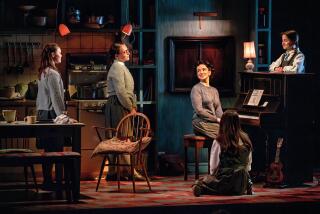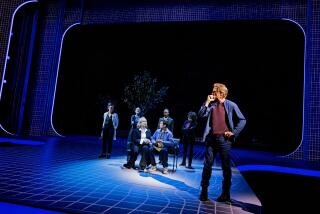Critic’s Notebook: ‘Hillary and Clinton’ playwright Lucas Hnath meticulously masters the messiness of life
Reporting from New York — Playwright Lucas Hnath is back on Broadway with “Hillary and Clinton,” a zesty drama on America’s most picked-apart political couple that finds Laurie Metcalf and John Lithgow in top form.
It’s not the Hillary and Bill play you might expect to see on Broadway right now. In a performance note at the top of the script, Hnath spells out that the actors should forgo any attempt at impersonating the Clintons: “Do not play for easy recognition. Don’t imitate. Don’t even try to cast actors who look like these people.”
Also, don’t come looking for breaking news. The play, set in 2008 during a crucial point in the Democratic primary when Hillary Clinton was being mowed down by an upstart senator named Barack Obama, has nothing to say (at least directly) about Clinton’s monumental defeat in the 2016 presidential election to wildcard Donald Trump.
“Hillary and Clinton” had its world premiere in April 2016 at Chicago’s Victory Gardens Theater when Hillary was still fending off a formidable primary challenge from Sen. Bernie Sanders. Hnath has revised the work for the Broadway production (expertly directed by Joe Mantello at the Golden Theatre), but he hasn’t altered the basic structural design.
We’re invited to watch a play about Hillary and Bill Clinton that’s rooted in a historical moment but performed at a remove from both the cable chatter and from the popular dramatic forms of historical masquerade. The characters are super-familiar, but the strange lens through which they’re viewed is Hnath’s and Hnath’s alone.
“Hillary and Clinton” didn’t receive a Tony nomination for best play, though Metcalf has been nominated for her rewardingly Metcalfian performance. (A Tony winner for her portrayal of Nora in Hnath’s “A Doll’s House, Part 2,” she has become a leading interpreter of the playwright’s work.) Some have dismissed the play as being thin to the point of evanescent, but that may be because it doesn’t satisfy the insatiable biographical hunger for answers that these irreducibly complex figures provoke.
The trickiest challenge of “Hillary and Clinton” is adjusting to a style that doesn’t allow for audiences to reflexively restart old arguments. The play is conducted on Hnath’s terms, which are abstract yet flecked with just enough idiosyncratic color to make it more than an intellectual exercise.
At the outset, Hillary (speaking in a microphone) urges us to imagine an infinite universe of infinite earths, with one containing a slightly different Hillary Clinton determined to become the first female U.S. president. Hnath foregrounds the physics of his theatrical foray into historical fiction to reveal some objective laws about the plight of a powerful woman hemmed in by the patriarchy. But in the end, it’s Metcalf’s intimation of her character’s somber consciousness of limits — those imposed from without and those glimpsed from within — that stirs and enlightens.
Hnath has leaped to the front ranks of the American theater. He’s not only prolific (his latest work, “Dana H.,” has its world premiere June 2 at the Kirk Douglas Theatre), but also popular: “A Doll’s House, Part 2,” which had its world premiere in 2017 at South Coast Repertory shortly before a starrier production opened on Broadway, was the most produced play of the 2018-19 season. But it’s taken a little time to get a handle on his singular qualities as a dramatist.
Art critic Robert Hughes popularized the phrase “the shock of the new” to describe the way modern artists have challenged their reception by rejecting the prevailing conventions of perspective. It’s hard to be shocked in a cultural world that has become so adept at coopting and corporatizing the avant-garde, as Hughes himself recognized. Hnath, whose experimental side is low-key and comically accessible, didn’t so much shock his audience when he burst onto the scene as raise a few eyebrows.
When “The Christians” came to the Mark Taper Forum in 2015, I admired the dialectical intelligence but was somewhat skeptical of the way argument substituted for plot. Much as I appreciated the unschematic nature of this tale of a smug pastor who departs from orthodoxy with good (if self-satisfied) intentions only to be slapped down by a congregation that refuses to have a fundamental tenet of faith discarded by fiat, the structure seemed skeletal.
But I was only becoming acquainted with a playwright who melds a unique set of influences: Plato’s dialogues, Brecht’s epic theater, Shaw’s comedy of ideas and Mamet’s stylish polemics, to name the most prominent. Hnath’s plays present pressurized situations in which characters are compelled to thrust and parry over their deepest held convictions. Thought doesn’t preclude emotion, but it usually takes precedence.
In focusing his dramas on the minds of his characters, Hnath inevitably leaves out of a fuller picture of their lives. There’s nothing wrong with this approach, as Euripides magisterially proved in his argumentative tragedies more than two millennia ago. But for a theater in which the default is an elaborately furnished realism, it can take some getting used to. Similarly, the presentational style of Hnath’s work (the Brechtian scene titles, the visible gap between actor and character) can discommode those theatergoers wanting to get lost in dramatic illusion.
In “A Public Reading of an Unproduced Screenplay About the Death of Walt Disney,” an early work in which Hnath was still discovering his voice, the distancing effects were perhaps too effective at keeping us at bay from Walt Disney’s egomaniacal crusade to defeat death while he could still draw hectoring breath. “A Doll’s House, Part 2” was the play in which Hnath’s cool intellect and his characters’ fervid emotions clicked into place.
Having written two positive reviews of the play, I still get messages from theatergoers who think this cheeky sequel is overrated. Some of this sentiment is understandable: Few dramatists can stand comparison with Ibsen. When Nora slammed the door on her husband at the end of “A Doll’s House,” modern drama came into existence. How we evaluate dramatic writing continues to be influenced by the revolution in realism fomented by Ibsen, Strindberg and Chekhov as the 19th century gave way to the 20th.
Hnath is proudly post-Ibsen in the freedom he insouciantly claims for himself. In “A Doll’s House, Part 2,” he pulls off an incredible time-bend between Ibsen’s era and our own. Picking up the plot 15 years after Nora walked out of Torvald’s life, Hnath updates the conversational manner and ditches the realistic upholstery.
The pacing of this domestic reckoning, divided into a series of heated colloquies between Nora and the loved ones she left behind, is breathless. The characters are justifying their very lives. Critical thought supersedes cathartic release, but it’s the specificity of the sad, sorry, stoical and often seething voices that moves us to attend so closely to the arguments.
In the Broadway production smartly directed by Sam Gold, Metcalf’s Nora was both proud and pained. The actress’ flamboyant virtuosity — her ability to detonate any line into laughter while holding fast to what is scared, fragile and tender — made the clashes with Chris Cooper’s Torvald, Jayne Houdyshell’s Anne Marie (the old nanny) and Condola Rashad’s Emmy (the daughter) so enthralling.
DIANNE WIEST: The actress on Beckett, ‘Law & Order’ and Woody Allen »
“Hillary and Clinton” is organized in a similar geometric pattern. Set in a New Hampshire hotel room, Hillary meets with Mark (a delightfully bearish Zak Orth), her frazzled campaign strategist (the Mark Penn of this particular parallel universe), who insists she distance herself from Bill after the trouncing in Iowa. She then meets with Bill (Lithgow, as perfectly suited to Hnath’s style as Metcalf), who wants to help Hillary win his way — by connecting slobberingly with voters. And then there’s a standoff with the unrufflable Barack (an elegantly icy Peter Francis James), who has offered her a spot on his ticket as vice president before winning the nomination himself — a Faustian bargain Bill is dead set against.
Although surrounded by these outsized male egos, Hillary’s own ego is too prodigious and her willingness to play political hardball too avid to provoke much sympathy. But what Hnath and his cast led by Metcalf let into the play’s tidy arrangements is regret over the human messiness that is an inescapable part of life.
The eminent critic Eric Bentley advised that with an Ibsen play it was essential “to look for the idea behind the idea.” He was pointing out that the social issues garnering so much attention aren’t what “A Doll’s House” or “Ghosts” is ultimately about. Behind the attention-grabbing debate is a deeper drama of the individual spirit that the actor is invited to endow with his or her own lineaments.
Hnath arranges his plays along the neat lines of a logician, but he’s ultimately interested less in the firmly held positions of his characters than in the subtle shifts of ambivalent recognition flickering across the screens of their minds.
Metcalf has a genius for turning on a dime. Her Hillary can crumple in defeat only to come out charging before turning her head in fatalistic dismay. Rage turns to irony over the course of a single line. Her vibrant theatricality motors the play without becoming a distraction. Lithgow complements her in this regard and in his ability to supply just enough character particularity without bogging the play down in unnecessary portraiture.
To the disappointment of some theatergoers and critics, “Hillary and Clinton” ends no political debate and solves no marital riddle. But that really isn’t a playwright’s job.
What Hnath does achieve — and it’s something that has come about through his collaborations with an actor as agile and grounded as Metcalf — is an illumination of the human muddle driving the arguments between men and women into eternity.
TONY NOMINATIONS: Sorting out an eclectic, erratic season — with mixed results »
More to Read
The biggest entertainment stories
Get our big stories about Hollywood, film, television, music, arts, culture and more right in your inbox as soon as they publish.
You may occasionally receive promotional content from the Los Angeles Times.











